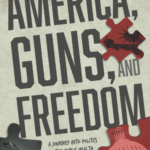Textbook Bias Against Israel
Students often assume that everything written in a textbook is a fact, sacred lines of text that cannot be contradicted. After all, that is why we lug around those 30-pound volumes every day. We’ve used textbooks since elementary school, and we have been led to believe that all textbooks can be trusted.
Yet textbooks are human creations, and humans inevitably bring their own experiences and biases into their work. Opinions often creep into the “facts” we are supposed to learn, and omissions and distortions are surprisingly commonplace.
Take Chapter 34 of the history textbook entitled Civilization: Past and Present (10th ed.), used in Sage Hill’s freshman classrooms. Less than fifteen pages of this chapter are devoted to the complex story of the modern Middle East. The entire section is plagued by myths, distortions and omissions that all serve to paint Israel in a negative light.
For example, right at the beginning of the discussion concerning Israel’s creation in 1948, we are told that “In 1947, plagued by Zionist terror tactics (author’s emphasis), Britain transferred the question of the mandate for Palestine to the United Nations.” This leads the reader to conclude that Britain abandoned Palestine to the U.N. solely because of Zionist terror tactics, and fails to mention the many horrible atrocities, riots, and massacres committed by the local Arabs in the preceding years under the influence of Haj Amin el-Husseini and others.
The book goes on to say that “[the] resulting partition plan, which gave most of the territory of Palestine to the Jews (author’s emphasis), was rejected by the Arab League.” This is false and feeds into the myth that Israel is and was a colonial land-grabber. In fact, nearly 80% of the historic Land of Palestine, as defined by the League of Nations, was severed by Britain in 1922 and allocated to what became Transjordan; the remaining 20% was partitioned into Jewish and Arab states. Of that 20%, land was divided between the Palestinian State and the Jewish State according to population; areas with more Arabs were given to the Palestinian State, and areas with a larger Jewish population were given to the Jewish State. Under Section B, Part II of the U.N. Partition Plan, over 60% of the proposed Jewish State was to be comprised of the Negev, an uninhabitable desert in southern Israel.
After inaccurately reporting the events of the Six Day War, the book continues, “Now Israel had three types of residents: Jewish citizens, Palestinian citizens (Muslim and Christian) with second-class citizenship status, and individuals under military occupation who had no citizen’s rights.” The characterization of second-class citizenship (author’s emphasis) status is factually incorrect. Israeli Arabs and Christians have the right to vote, to own property, to engage in any profession, and to serve as representatives in the Knesset. In 2003, three Arab political parties, out of a total of thirteen parties, participated in the Knesset. While Jews are the majority, minority rights are protected by the Declaration of the Establishment of the State of Israel, which states “it [Israel] will ensure complete equality of social and political rights to all its inhabitants irrespective of religion, race or sex; it will guarantee freedom of religion, conscience, language, education and culture.”
Distorting facts often creates a false impression, as shown in this statement: “The UN responded to the 1967 war with Resolution 242, which recognized Israel’s right to exist but ordered the return of the (author’s emphasis) occupied territories.” Resolution 242 clearly states under Operative 1(i), “Withdrawal of Israel armed forces from territories occupied in the recent conflict.” The omission of the word “the” was intentional; the U.N. acknowledged that Israel had the right to adjust its pre-1967 borders. Therefore, Israel is not required to withdraw from all the land it gained in the Six-Day War.
According to the textbook, “the PLO worked to organize resistance to Israel. It supported political activities, schools for Palestinians, work programs, and military and guerrilla training.” The PLO supported more than “training”. It has been responsible for the wanton murder of Israeli and American citizens, Arab and Jewish alike, and other foreign nationals. The PLO created the tactic of airline hijacking, first used on July 22, 1968, on a flight from Rome to Tel Aviv. The U.S. State Department considers the Popular Front for the Liberation of Palestine and Fatah, two of the original members of the PLO, to be terrorist organizations. According to the U.S. State Department’s Patterns of Global Terrorism, 2003: “[the PFLP] committed numerous international terrorist attacks” and Fatah “has carried out terrorist attacks in twenty countries.”
We are also told in Civilization that “Hamas is an Islamist party that rejects Israel and advocates the implementation of Shariah law.” In fact, Hamas is more than a political party; it is a terrorist organization on the U.S. State Department list of Foreign Terrorist Organizations; it has perpetrated countless large-scale suicide and bomb attacks on civilians, and often targets Palestinians suspected of assisting Israel. In December 2001, the European Union listed the terrorist wing of Hamas as a terrorist organization (Common Position 2001/931/CFSP). In September 2003, it listed the entire organization of Hamas as a terrorist group (Common Position 2003/651/CFSP).
Textbooks should be assigned to serve only as the starting point for learning about a particular topic. Teachers should encourage us to consult original sources and a variety of other published materials on the topic, so that we can learn from other experts and get a range of opinions.
The bottom line: Textbooks don’t always tell the truth. Learn to read them with a critical eye.
Danielle Glazer is a freshman at Sage Hill, a private college preparatory school in California. She has attended four summer writing courses at the Johns Hopkins Center for Talented Youth.



